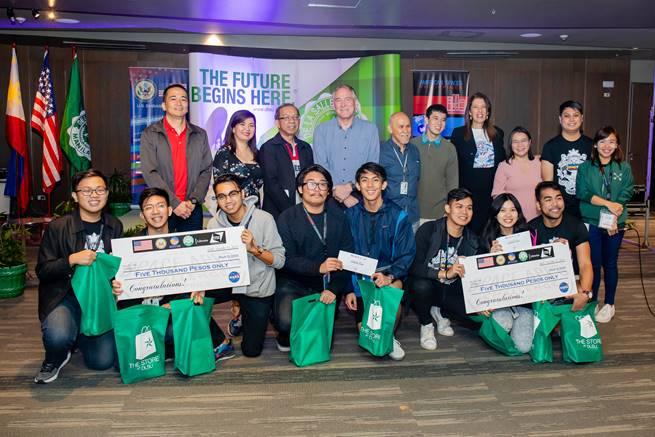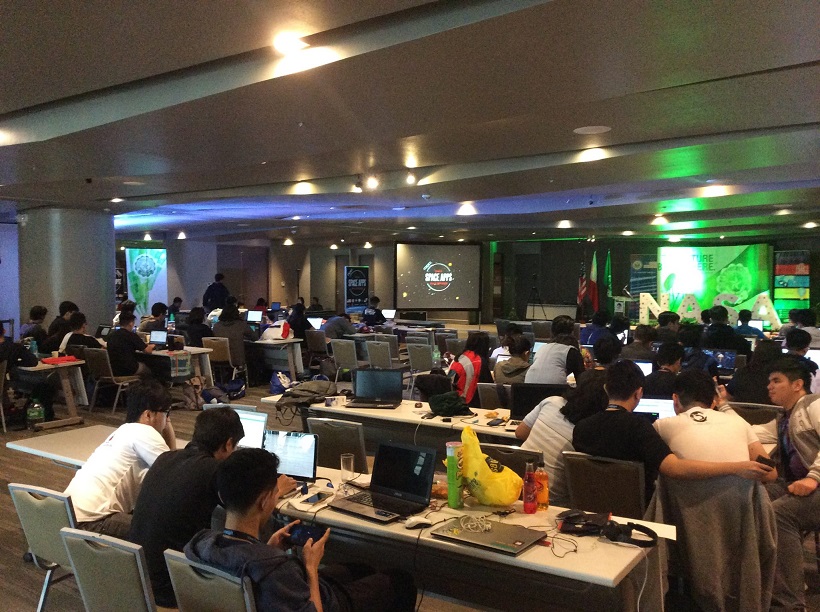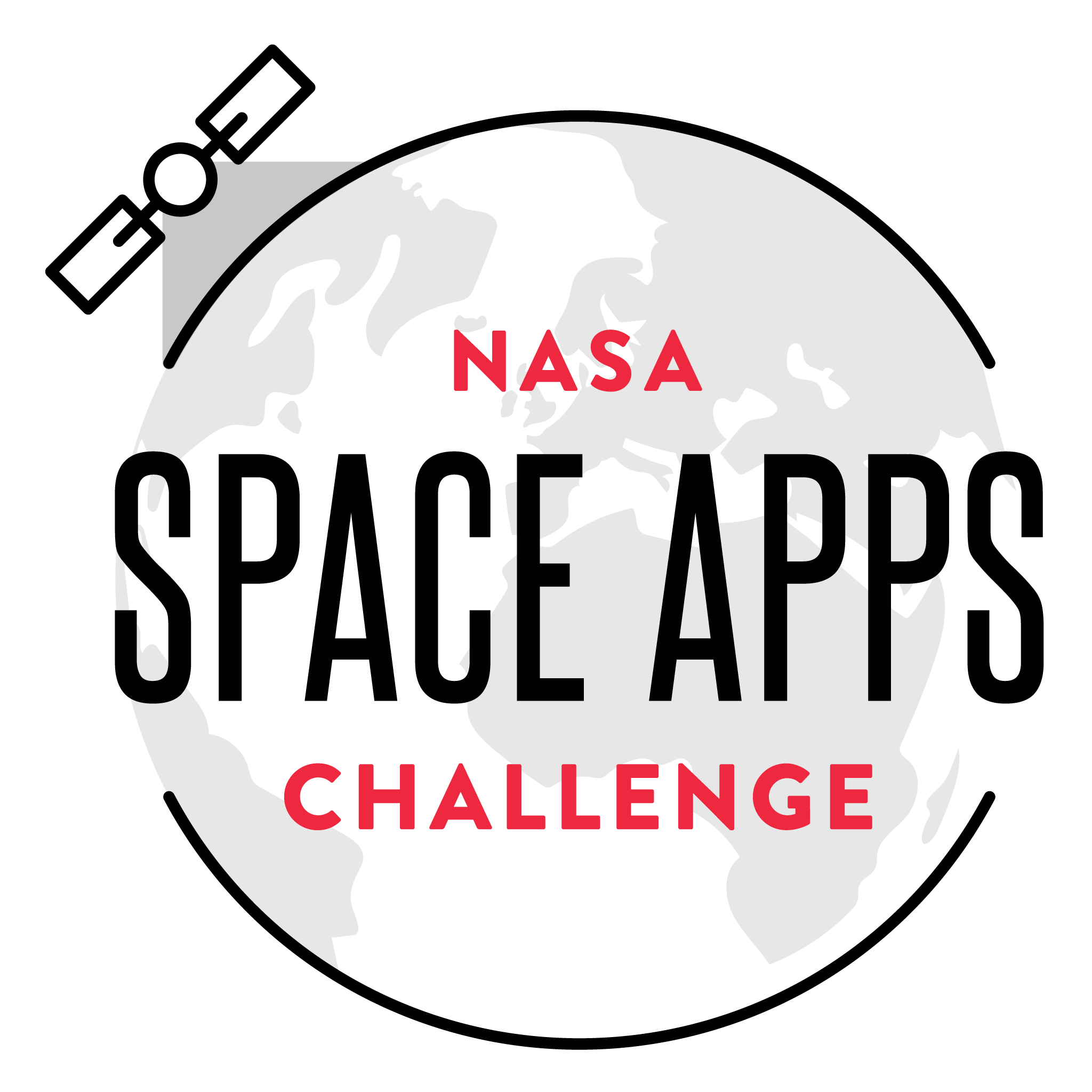
Up to the NASA challenge. Back, left to right : Leandro T. Santos, head,PLDT Enterprise Core Business Research and Development; Yvette M. Cabrera, DOST senior planning officer; Raul C. Sabularse, deputy executive director DOST-PCID Energy and Emerging Technology Research and Development; US Embassy deputy chief of mission John C. Law; Animo Labs executive director Federico C. Gonzalez; lead organizer Michael Lance M. Domagas; Jeanie M. Duwan, US Embassy assistant cultural affairs officer, DLSU librarian Christine M. Abrigo; Randolf D. Mariano, US Embassy American Spaces Philippines; and Donna Lyn G. Labangon, DLSU American Corner.
Front: Eugenio Emmanuel A. Araullo, Rainier G. Narboneta, Jeorge Loui P. Delfin, Bluen Ginez, and Samuel Jose-all of Space Force; Julius Czar Torreda, Marie Jeddah Legaspi, and Revbrain G. Martin of INON
An app that would enablefishermen to receive scientific data without Internet connection developed by a group of Filipino Information Technology professionals is one of the 25 finalists in the the NASA Space Apps Challenge, global level,after a three-day hackathon held recently at the De La Salle University in Malate.
There will be six winners expected to be announced in mid-January 2019. They will receive an invite to visit NASA’s Kennedy Space Center in Florida.
Named ISDApp, from the Tagalog word “isda” meaning fish, the appsends useful information to fishermen such as real-time weather, sunrise and sunset, wind speed, and cloud coverage to plan their fishing activities using the NASA GLOBE Observer app, a data collection from citizen scientists around the world used in concert with NASA satellite data to identify or communicate information, and educate the public about planet Earth.
NASA is the National Aeronautics and Space Administration, the United States federal agency responsible for aerospace research, aeronautics, and the civilian space program.
The winning app was developed by ateam of Filipino IT professionals who call themseves iNON, which stands for “It’s now or never”. iNON iscomposed of Revbrain G. Martin, Marie Jeddah Legaspi, and Julius Czar Torreda.
The selection of ISDApp was made during a hackathon last October 19-21 held at De La Salle University in Malatein collaboration with the Embassy of the United States of America to the Philippines and Philippine Long Distance Telephone Company. At the hackathon, held simultaneously in 200 locations all over the world, participantscreated a functional prototype of their proposed idea.
The US Embassy gave ₱ 5,000 for the two winners.
The jurors were US Embassy deputy chief of mission John C. Law; Leandro T. Santos , head of PLDT Enterprise Core Business Research and Development; Raul C. Sabularse , deputy executive director, DOST-Philippine Council for Industry, Energy and Emerging Technology Research and Development; Yvette M. Cabrera, senior planning officer, Department of Information and Communications Technology; and Animo Labs executive director Federico C. Gonzalez.
ISDApp enablesfishermen to receive SMS notifications from the Amazon Web Services gateway while local government officials would manage their details using a smartphone app connected to the cloud.
An emergency checklist kit app designed for disaster preparedness also won at the local level developed by students Jeorge Loui P. Delfin, Bluen Ginez, Samuel Jose, Rainier G. Narboneta, and Eugenio Emmanuel A. Araullo.
Global finalists nominated for the “Global Impact” category is described by NASA as “the solution with the most potential to improve life on Earth or in the universe”

The techies deep at work during the Space Challenge.
Other projects and solutions proposed during the October hackathon are games using images from the Hubble Space Telescope; augmented reality mobile app to tell a story of the changes in the Arctic and Antarctic ice; artificial intelligence app helping scientists confirm the habitability of exoplanets, and story-based game using NASA Earth imagery.
Before the hackathon, overseen by Patricia Jacobberger, a senior adviser of the NASA Earth Science Division, a day-long data bootcamp was held where participants learned new concepts, strategies and skills from scientists and experts .Michael Carroll from Urban Engine in Huntsville, Alabamaand NASA Earth Science Division senior advisor Dr. Patricia Jacobberger introduced Space Apps through a virtual talk while NASA astronaut Drew Feustel, orbiting aboard the International Space Station welcomed everyone to the event. US Embassy science fellow Dr. Anondo Mukherjee and US Fulbright fellow Sarah Marie Hartman gave an online lecture about the Earth’s environment.
DOST-Advanced Science and Technology Institute acting director Dr. Joel Joseph S. Marciano, Jr. and PHL-Microsat program leader Dr. Marc Caesar R. Talampas discussed microsatellite development and advanced technologies in the Philippines.
During the hackathon period, teams worked on finding solutions to themed challenges put forth by NASA. They work together with the rest of the world on hackathon weekend to devise creative and innovative solutions to these challenges.
Projects were nor limited to apps. Participants collaborate to build anything — from open-source software, hardware, data visualizations, and citizen science platforms, to videos, art, and other communications solutions — aimed at addressing global challenges.
The overarching theme of the 2018 challenges was “Earth and Space,” underscoring the connections between major challenges, and the potential solutions to them, both on Earth and in space. The 2018 mainstage Space Apps event was hosted by Urban Engine in the US Space and Rocket Center at Huntsville, AL, also known as “The Rocket City.”
Those who served as mentors during the Hackathon includedRyan Madrid and Malcolm Flores, alumni ofYoung Southeast Asian Leaders Initiative; DLSU professors Jordan Aiko P. Deja and Neil Patrick A. Del Gallego; PHL-Microsat engineers Ariston N. Gonzalez; Lorenzo Sabug, Jr.; Benjamin Joseph D. Jiao; and Carlo D. Pastoral, Amazon Web Services developers John Luis Garcia, Dennis Magsajo, and Randy Bardaje;, Animo Labs incubatee and MachiBox CEO Simon Gregory Mabanta, VR Philippines lead Cristopher David, Mobility IT 4 Youth lead Art Polo Gabriel III, nuclear physicist Dr. Jasmine Albelda, and entrepreneur Ibba Bernardo guided participants in creating their winning apps and solutions to solve problems on Earth and space.
Since its inception in 2012, the International Space Apps Challenge has become the world’s largest global hackathon, engaging thousands of global citizens to collaborate in building innovative solutions to complex challenges using NASA’s open data. Hackathons are technology development marathons that draw on the talents and initiative of bright-minded people. Space Apps inspires local innovation communities to convene, cooperate, and create.
( The author is the 2018 Hackathon Manila lead organizer. This
story is produced by VERA Files under a project supported by the Internews’
Earth Journalism Network, which aims to empower journalists from developing
countries to cover the environment more effectively.)
